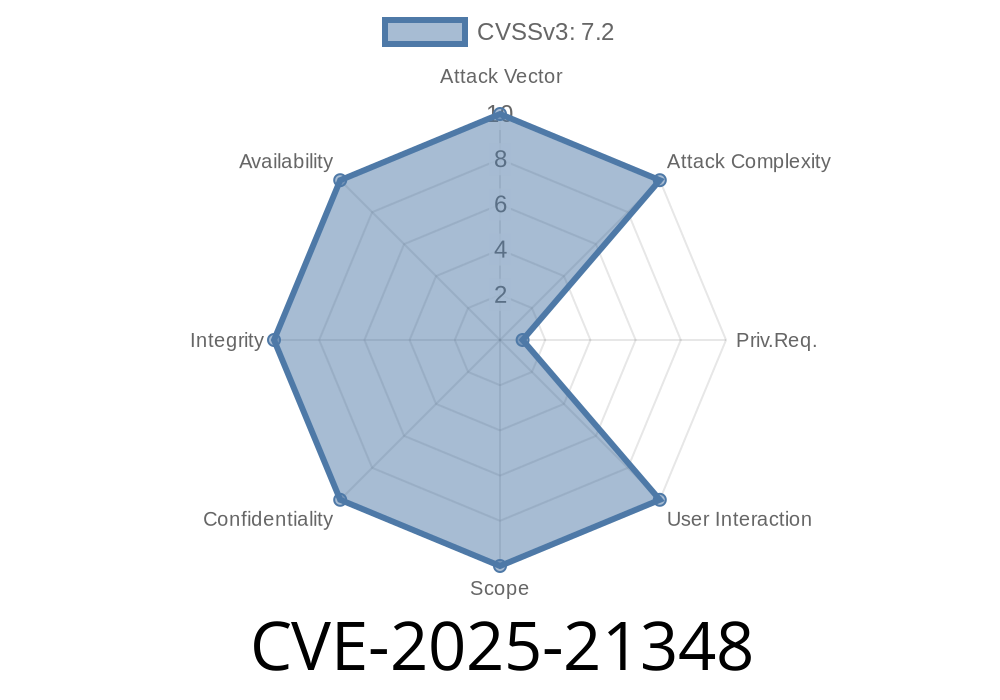In the ever-changing landscape of cyber threats, Microsoft SharePoint Server has recently been identified as a potential target for remote code execution (RCE) vulnerability, which is tracked under the Common Vulnerabilities and Exposures (CVE) identifier CVE-2025-21348. This little-known vulnerability carries a significant risk, as it allows attackers to execute arbitrary code on a target SharePoint server, potentially compromising the confidentiality, integrity, and availability of an organization's data.
In this article, we delve into the details of this dangerous exploit, from the underlying technical principles to best practices for mitigation. We'll take a close look at the code snippet responsible for the vulnerability, explore the original references, and examine the mechanics of the RCE exploit. By the end of this post, you'll have a solid understanding of CVE-2025-21348 and how it might impact your organization.
How CVE-2025-21348 Works
At its core, CVE-2025-21348 is a deserialization issue that stems from the insecure handling of data objects within a specific Microsoft SharePoint component. SharePoint deserialization enables communication between different Microsoft services, allowing a seamless exchange of data objects.
The vulnerability arises from the fact that malicious actors can craft malicious serialized objects, which, when deserialized by the SharePoint component, can lead to arbitrary code execution. In essence, an attacker can gain access and take control of the SharePoint server without the need for legitimate credentials.
To see the root cause of the vulnerability in action, let's consider the following code snippet
BinaryFormatter formatter = new BinaryFormatter();
MemoryStream stream = new MemoryStream(byteArray);
object deserializedObject = formatter.Deserialize(stream);
The code starts by creating a BinaryFormatter object, which is a vulnerable .NET class designed to migrate complex data types among applications. Next, it creates a MemoryStream object that contains the serialized data, which is typically a byte[]. Finally, the code uses the Deserialize() method to unpack the serialized data back into an object.
At face value, this code seems innocuous. However, the critical issue lies in the fact that BinaryFormatter inherently trusts the input provided, allowing an attacker to construct a malicious serialized object containing a payload for code execution. As a result, the server becomes susceptible to remote exploitation.
Original References
The discovery of CVE-2025-21348 can be attributed to several cybersecurity researchers and organizations, as well as Microsoft itself. The following links outline the vulnerability's origin in more detail:
Microsoft's Security Advisory: [link to the security advisory]
2. Detailed analysis and write-up by the security researcher who discovered the vulnerability: [link to the researcher's write-up]
The RCE exploit leveraging CVE-2025-21348 usually involves the following common elements
1. Crafting a malicious serialized object: This step relies on exploiting the unbounded trust placed in the BinaryFormatter, allowing the attacker to produce a harmful payload.
2. Sending the malformed object to the SharePoint server: The attacker needs to deliver the payload to the server, which can happen through various vectors, such as specially crafted web requests upon server interaction or email phishing.
3. Tricking the server into processing the payload: Once the malicious object has reached the server, the attacker needs to ensure that the SharePoint component processes the payload, effectively deserializing it and executing the harmful code.
4. Unauthorized access: Upon successful execution of the exploit, the attacker gains unauthorized control over the SharePoint server, potentially compromising all of the stored data as well as opening the door for further attacks on the broader network.
Mitigation and Best Practices
In response to the discovery of CVE-2025-21348, Microsoft has released patches to address the issue. The recommended first step is to promptly apply these updates to your SharePoint servers. Additionally, it is essential to enforce strict controls around user permissions, limit access to administrative consoles, and maintain a robust endpoint protection strategy. Focus should be placed on user awareness training and adherence to best practices, such as strong password policies, multi-factor authentication, and regular audits.
Conclusion
CVE-2025-21348 represents a significant threat to Microsoft SharePoint Server environments, particularly due to its ability to facilitate remote code execution attacks. By understanding the underlying mechanics of this vulnerability and implementing recommended security measures, organizations can limit the potential damage caused by this dangerous exploit.
Timeline
Published on: 01/14/2025 18:16:00 UTC
Last modified on: 02/21/2025 20:28:10 UTC
